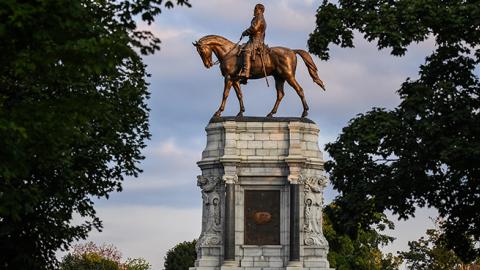With Halloween over and the full implications of Election Day looming, let us take a moment to imagine a future in which America’s political norms and institutions have collapsed, allowing an authoritarian party to seize power. Among the nightmares conjured by such imagining, let us focus on one: the possible fate of America’s public monuments. As David Blankenhorn wrote here recently, “We humans saturate the physical landscape with intentional displays of moral meaning [that] … cry out to the living and the unborn: ‘This is who we are, where we stand, and how we aim to be remembered.’” There’s no need to specify which side in today’s culture war would be quicker to summon the bulldozers.
Relevant here is a 1985 essay by historian Richard Stites about the cultural upheavals following the Bolshevik Revolution, in which he distinguishes between “mindless vandalism,” of the sort committed during peasant revolts throughout Russian history, and “iconoclasm proper,” meaning the “self-conscious removal or demolition” of “hated images and artifacts of the past” in order to replace them with “new symbols and emblems.” Contrary to official Soviet history, Stites does not impute to angry peasants trashing the property of landowners the same ideological motives driving revolutionaries to attack imperial eagles, czarist statues, and Orthodox churches.
Americans experience more mindless vandalism than iconoclasm proper, so this distinction can be lost on us. For example, last August, when a splotch of red paint appeared on the statue of Robert E. Lee on Monument Avenue in Richmond, the Richmond Times-Dispatch did not use the term “iconoclasm,” much less “iconoclasm proper.” Of course, no sane newspaper would use such a word. But neither did the paper highlight the political nature of the act. Instead, it was reported as “vandalism,” even though the “vandal” signed the splotch “BLM,” the acronym for Black Lives Matter.
If the blue-state authoritarians were driving the bulldozers, Lee and his fellow Confederates would soon bite the dust. But iconoclasm proper is harder to pull off in a democracy, even a struggling one like Macedonia. Consider the latest news from Skopje, where a 27-year conflict with Greece has found a focus in one highly visible monument.
Since 1991, when the Republic of Macedonia declared its independence from the former Yugoslavia, its efforts to join the European Union and NATO have been stymied by Greece, on the ground that by calling itself “Macedonia,” the new nation was staking a claim both to the northern part of Greece that goes by the same name, and to the classical heritage associated with King Philip of Macedon and his son, Alexander the Great. In 2015 former Prime Minister Nikola Gruevski spent €7.1 million on a 50-foot-tall statue of a wavy-haired hero wearing a buff muscle cuirass and seated on a rearing stallion atop a 30-foot column. Currently known as “Warrior on a Horse,” the hero holds a sword in his right hand, and with his left pulls so tightly on the rein that his mount seems in danger of toppling. Not only that, but while warrior and horse are reasonably well sculpted, the work seems amateurish. Artists without classical training tend to make heads too big, and that error is discernible here. The stallion’s forequarters are proportionately larger than his hindquarters, and the fact that he is rearing only makes the statue more top-heavy.
But if our stallion can hold his pose long enough, his rider may soon have a new name. Subsequent to a referendum held in September, the current Prime Minister, Zoran Zaev, agreed to the Greek demand that his country be renamed North Macedonia. If all goes well, North Macedonia will join the European Union and NATO, and it will be kosher to call the statue Alexander, as long as the authorities add a plaque explaining that Alexander was part of “Hellenic culture,” as opposed to the predominantly Slavic culture of the current population.
Can Americans hope for a similar resolution with regard to Robert E. Lee and other wavy-haired heroes of the Confederacy? I fear not, because, unlike the Macedonians and Greeks, the two sides in our culture war are no longer staking rival claims to the same heritage. On the contrary, the more fanatical defenders of the Confederacy dream of reviving the Lost Cause, while the more zealous “woke” folk dream of razing the entire symbolic landscape.
Have pity, then, on the Office of the Mayor and City Council of Richmond, which this past July released a report by the Monument Avenue Commission, a 10-member group that had spent the previous year trying to reconcile all viewpoints on the question of how best to deal with what Mayor Levar M. Stoney called “one of the most picturesque grand boulevards and urban residential neighborhoods in the world.” The report quotes the mayor’s original charge that, rather than remove the Confederate statues lining the wide, tree-lined mall dividing the street, the commissioners should seek ways to “add context.” But when this charge was shared with the public, the responses were “swift and visceral”: “Why desecrate the beauty and history of Monument Avenue?” “Why is ‘removal’ not a consideration?” “What does ‘context’ mean?”
The first two questions echo the arguments that typically erupt on this topic, and unsurprisingly, the second resulted in the commission adding “removal” to its list of unlikely solutions. More intriguing is the third question, because “adding context,” or the more academic-sounding “contextualization,” is not a notion that springs readily to the mind of the average citizen. This, I suspect, is why Mayor Stoner grabbed hold of it. Gauzily high-minded yet somehow warmly inclusive, “adding context” seems the perfect choice for civic leaders and politicians hoping to please all of the people all of the time.
But what does it mean? In Richmond, adding context is reported to mean “permanent signage” applied to every offending object, in order to provide a more “holistic narrative,” with a future plan to provide “mobile app and video to convey the history of the monuments and what they stand for.” In less cautious cities, contextualizing is celebrated as the deployment of “design provocations” for the purpose of “evoking powerful emotions” in a diverse public presumed to be seeking relief from the oppressive atmosphere exuded by racist and retrograde monuments.
The trouble is, the typical job of contextualizing is done by a well-credentialed artist steeped in postmodern theory, whose approach is long on words and short on visual eloquence of any kind, much less the kind that speaks to the general public. And while the results are usually praised in the local media, the general public tends not to care, either because they have other things to worry about, or because they find the whole business baffling and would rather look at a beautiful statue than read a placard explaining why they should feel offended by it.
Hence Mayor Stoner’s comment to the Richmond Times-Dispatch that “adding new statues, whether it’s the U.S. Colored Troops or Oliver Hill or Doug Wilder, would be an advancement for the city of Richmond.” This was of course done back in 1996, when a bronze sculpture of tennis champion Arthur Ashe was placed on Monument Avenue over the objections of a wide range of city residents—including one from a local arts group that “questioned the quality of the statue and called for a new one to be designed.”
That arts group had a point. Unlike the imposing monuments of Lee and his fellow Confederates, but unfortunately very much like Alexander in Skopje, the statue depicts Ashe with an oversized head and in an ungainly pose—both arms raised, racket in one hand, books in the other—that is supposed to evoke his twin achievements in sports and learning but more immediately suggests that he is about to toss the books in the air and smash-serve them over an invisible net.
More appropriate, but also more provocative in the former capital of the Confederacy, would have been a monument to the 175 regiments of U.S. Colored Troops, escaped slaves and freedmen, who fought on the Union side in the Civil War. Today that idea is under serious consideration, perhaps because there are now several such monuments around the country, the most venerable being the Memorial to Robert Gould Shaw and the Massachusetts Fifty-Fourth Regiment by Augustus Saint-Gaudens. Unveiled in 1897, that masterpiece now stands on Boston’s Beacon Hill, where the regiment marched past the Massachusetts State House on May 31, 1863.
One hundred years after the completion of the Saint-Gaudens, a similar monument was unveiled at the current location of the African American Civil War Memorial Museum in Washington, D.C. “The Spirit of Freedom” is a 10-foot-tall cylinder, like a tree trunk, from whose surface emerge an array of black soldiers, sailors, and civilians. Sculpted by the Louisville-based artist Ed Hamilton, the work departs drastically from the standard-issue hero on horseback but without sacrificing the power and expressiveness of lifelike figures—all of whom, I am happy to report, are well-proportioned and have heads no larger than the good Lord intended.
It pains me to say this, but all of this rather suggests that the best resolution of America’s monument wars may be Vladimir Lenin’s. As noted by Stites, the “currents of iconoclasm” were so violent after the Bolshevik Revolution that for a time it seemed nothing would survive. For Stites the question is, “Why did the storm which built up a ferocious power in the early revolutionary years not blow away all traces of the old culture and its makers?” And the answer is found in how Lenin spent the first anniversary of the Bolshevik Revolution on November 6-8, exactly 100 years ago this week:
bq(blockquote). Lenin participated in the festivities in a way that illustrated in capsule form his views of destruction and preservation. He left the Kremlin, a complex of architecture which he insisted on preserving but from whose premises he had banished the statue of Alexander III [who had Lenin’s older brother hanged after an uprising in 1888], and went into Red Square to attend the unveiling of newly erected revolutionary monuments. His festive mood was marred by the sight of provocative and abstract decorations by the Futurist participants. . .[Lenin] wished to preserve the great historical and artistic monuments of the past, even those intimately and graphically tied to name of Romanov. Lenin was a traditionalist in artistic taste and a political realist. . .The signs of an effete aristocracy could be banished to the museum; the excesses of ego-asserting Futurists could be toned down or curbed; and the ‘new’ signs of Revolutionary order could be fashioned out of elements of the old.
It may be objected that when Lenin’s cultural policies look good to Americans, we are in serious trouble. Lenin was a ruthless dictator responsible for uncountable deaths. But he was also the one, amid the vandals, iconoclasts, and fanatics of his age, who applied the brakes to the cultural desecration of Russia. Because of him, Stites reminds us somewhat ruefully, “the modern tourist on a successful visit to Leningrad [can] take in the Nevsky Prospect,. . .the Peter Paul Fortress, the Winter Palace, St. Isaac’s Cathedral, the Gold Room, the university, the Russian Museum, the Philharmonia, and the ballets of Tchaikovsky at the Kirov Theater.”7
It would be nice to think our struggling democracy could do the same.















